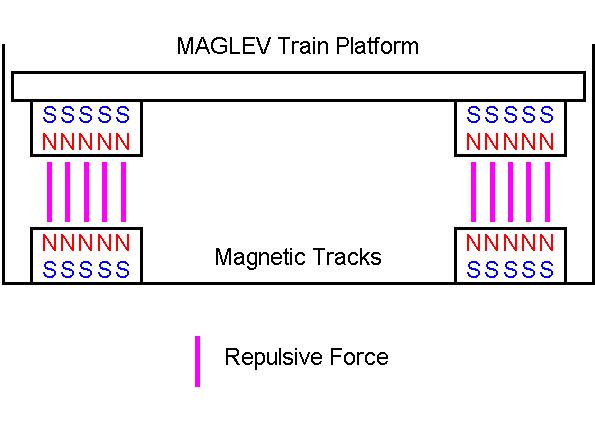


Experiments with magnets interacting with other magnets
Levitating Train
Description:

This is a great demonstration of like poles repelling each other. We have a platform which floats above a pair of magnetic tracks, and can be gently pushed to one end or the other. This is similar in concept to the MAGLEV trains which are being worked on in Germany, Japan and France.
Construction: ![]()

The tracks are simply two magnet strips, each measuring about 24"
long, 1/2" wide, 1/8" thick, with their North side facing up. They are
placed about 1/8" in from the edges of a piece of 3/4" thick wood shelving (with
a white melamine surface) base, 24" long and 4" wide. Ends and a back wall
are attached to the base, about 3" tall. The front of the base has a Plexiglas
wall attached to it, so that you can see the train platform float above the tracks.

The train platform is made of foam-core board, 3 and 7/8" wide by
6" long and 1/4" thick. On the bottom is a pair of magnet strips, about
6" long, 1/2" wide, 1/4" thick, with their North side facing down.
They are placed about 1/8" in from the side edges.

Attached to the ends of the base and to the ends of the train platform are
smaller disk ceramic magnets, placed so that the North ends face each other so that they
act as springs when the train reaches the end of the track. An extra strip of
foam-core board was added to the top and bottom to provide a larger area to attach the end
magnets.
Along the side edges of the platform was placed a strip of Teflon tape. This provided a very smooth, slippery surface for the train to rub against as it travels down the track. The back wall and the Plexiglas front wall are needed to keep the platform centered above the tracks. What would happen if they weren't there?
The LEGO people were added as passengers for interest.
An excellent site for more in-depth information on MAGLEV trains:
https://en.wikipedia.org/wiki/Shanghai_Maglev_Train
Demonstration:
Give the train platform a gentle push from one side to the other. You will see it float over the tracks. The magnets on the ends keep the platform from hitting the ends (don't smash it into the ends!).
Conclusions:
This is just a fun experiment which demonstrates the like poles
repelling principle of magnetics. There are four pairs of poles repelling each other
on this train.
This is a simplified diagram showing the areas of attraction and repulsion
between the magnets for this experiment.

The magnets we used for our experiment were from a kit put together by Dowling Magnets called Magnetic Levitation Set - SDK100.
Dowling Magnets Catalog
(http://www.jalts.com/nature/dowling).
Just A Lil' Toy Store
Char Herron
Postal Box 222
Arcadia, FL 34265
863 494 2980
They provided the two long magnet strips for the "tracks" as well as the two
shorter pieces for the bottom of the platform. We mounted the tracks onto a piece of
shelving, and used a piece of foam core board for the platform. This worked out better
than the wooden pieces which came with the kit. Don't forget the sides to keep the
platform centered above the tracks! This kit costs about $25, but it's possible to
purchase only some of the strip magnets for a lot less from Dowling Magnets.
Since the foam core platform we used was so light, the magnets do not have to be real
strong. With the ones that came in the kit, the bottom of the platform magnets float about
1/4" above the tracks.
Also available from Edmund 81-462, AS&S 89714